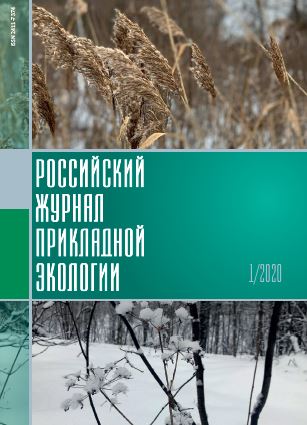Dynamics of growth of higher plants in reclaimed oil-contaminated alluvial meadow soils of different granulometric composition
Keywords:
oil, alluvial meadow soil, phytotoxicityAbstract
In laboratory chronic experiments, the influence of the oil content in the reclaimed alluvial meadow medium loamy and sandy loam soil on the yield of spring wheat biomass and sowing peas was determined. It was shown that peas are more sensitive to the residual content of oil products in the soil. When wheat is cultivated on reclaimed oil-contaminated soils, the toxic effect is manifested only in the early stages of plant development. When growing peas on contaminated medium loamy soil, the inhibitory effect was not manifested only in the variant containing 8.6 g/kg of pollutant. In other cases, inhibition of pea growth was observed with a tendency to increase in time in the variant containing 14.3 g of oil per kg. The development of peas in the early stages on sandy soil containing a minimal amount of pollutant was accompanied by stimulation of plant growth, when this effect was leveled by the end of the chronic experiment. The cultivation of peas at the maximum tested pollutant content in medium loamy and sandy loamy soils led to a decrease in bio productivity. The stimulation effect was observed in variants containing 1.5 and 6.0 g/kg of oil.
References
Akajkin D.V., Petrov A.M. Usloviya sredy i dinamika toksikologicheskih harakteristik neftezagryaznennyh pochv [Environmental conditions and dynamics of toxicological characteristics of oil-contaminated soils[ // Vestnik tekhnologicheskogo universiteta // Herald of tehnological university. 2016. V. 19, No. 8. P. 123–126.
GOST R ISO 22033-2009. Kachestvo pochvy. Biologicheskie metody. Hronicheskaya toksichnost' v otnoshenii vysshih rastenij [Soil quality. Biological methods. Chronic toxicity to higher plants].
Zajnulgabidinov E.R., Ignat'ev Yu.A., Petrov A.M. Osobennosti izmeneniya fitotoksichnosti dernovo-karbonatnoj i svetlo-seroj lesnoj pochv, zagryaznennyh nefteproduktami [Features of changing phytotoxicity of sod-carbonate and light gray forest soils contaminated with oil products // Zhurnal ekologii i promyshlennoj bezopasnosti [Journal of ecology and industrial safety[. 2014. No. 1-2. P. 35–37.
Ignat'ev Y.A., Zajnulgabidinov E.R., Petrov A.M. Primenenie metoda prokalivaniya dlya opredeleniya soderzhaniya allohtonnyh uglevodorodov nefti v seryh lesnyh pochvah [Application of a piercing method to determine the content of allochthonous oil hydrocarbons in gray forest soils] // // Rossijskij zhurnal prikladnoj ekologii [Russian journal of applied ecology]. 2018. No. 3. P. 34–37.
Kol'cova T.G., Grigor'yan B.R., Sungatullina L.M., Petrov A.M., Bashkirov V.N. Ocenka fitotoksichnosti seryh lesnyh pochv v usloviyah neftyanogo zagryazneniya [Assessment of phytotoxicity of gray forest soils under oil pollution] // Vestnik tekhnologicheskogo universiteta [Herald of tehnological university]. 2016. V. 19, No. 18. P. 185–191.
Kol'cova T.G., Sungatullina L.M., Grigor'yan B.R., Petrov A.M. Ocenka fitotoksichnosti chernozemnyh pochv v usloviyah neftyanogo zagryazneniya [Assessment of phytotoxicity of chernozem soils under oil pollution] // Vestnik Kazanskogo tekhnologicheskogo universiteta [Herald of tehnological university]. 2014. V. 17, No. 15. P. 261–267.
Petrov A.M., Vershinin A.A., Karimullin L.K., Akajkin D.V., Tarasov O.YU. Dynamics of ecological and biological characteristics of sod-podzolic soils under conditions of prolonged exposure to oil pollution [Dinamika ekologo-biologicheskih harakteristik dernovo-podzolistyh pochv v usloviyah dlitel'nogo vozdejstviya neftyanogo zagryazneniya] // Pochvovedenie [Eurasian soil science]. 2016. No. 7. P. 848–856.





